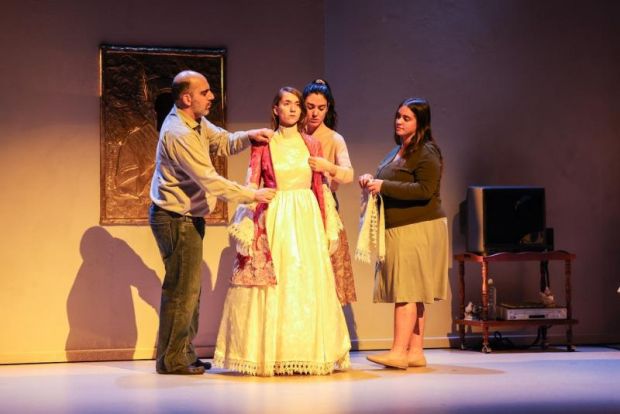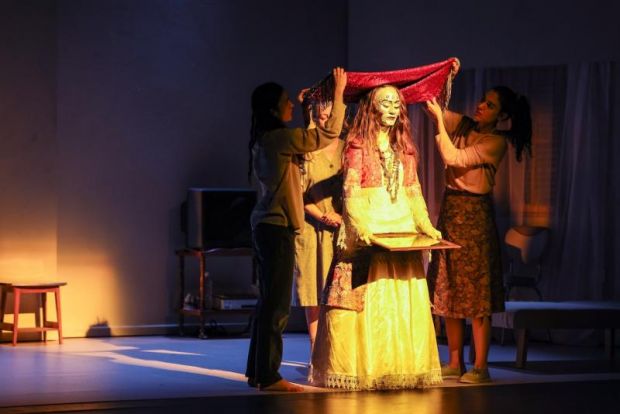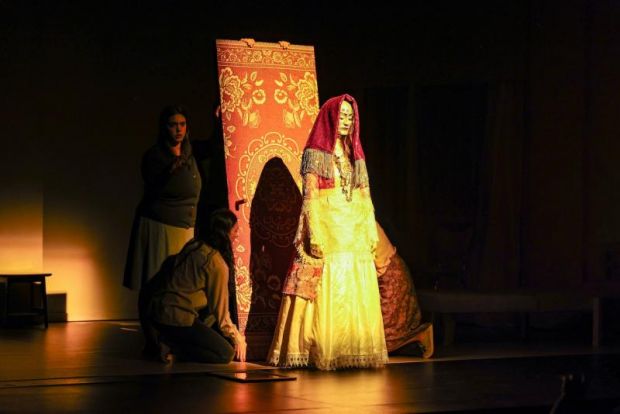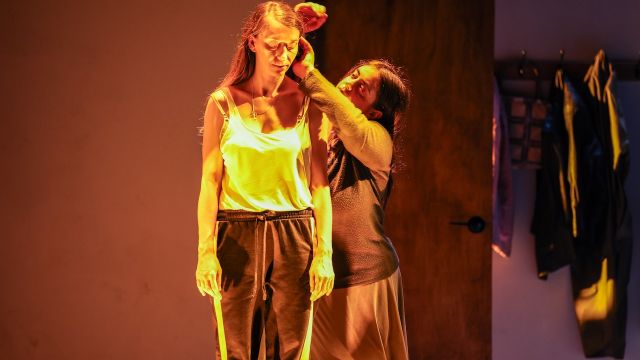Goodbye, Lindita
Born in Albania in 1998, Mario Banushi is a director and actor and the creative force behind Goodbye, Lindita which premiered at the National Theatre of Greece in March 2023, the second work in a planned trilogy. He moved to Greece at the age of six and went on to study drama at the Athens Conservatory. Much of the heavy symbolism in this piece hails from the director’s cultural ties to the Balkan regions; indeed the work was inspired in part by the enduring image of Banushi’s stepmother surrounded by flowers upon her deathbed.
Exploring the state of grief and ritualised mourning, the performance delivers a richly visual convolution of layered scenes, symbols, and imaginings without any text being uttered during the 70 minute performance. Curtain up reveals family members set within an elemental domestic scene with background sounds bleeding through: dogs barking, road noise, birdsong, voices of people passing on the street. The family is watching television, tidying, cleaning, napping. The cast proceed to move sets and props with sturdy, dreamlike deliberation, in a haze of what we come to realize is grief. In time, a chest of drawers is rolled downstage transforming into a platform of sorts to reveal a supine, deceased female figure. These seeming acts of utility begin to shift the setting from the mundane to the abstract as the tasks become less functional and more agitated.

In the first instance, the pace of this work is slow, steady, and processional and draws the audience into the meditative sense of ritual and solemnity. Initially the design palette is quite muted and neutral, even sombre. Lighting too is at a low level apart from a warm, directional glow cast through a doorway or window. As the women of the group tend to the dead woman lighting is more direct, bathing the intimate scenes with a more sacred, painterly tone.
Recurring sounds throughout are the mother’s audible weeping and the communal keening from female mourners which contrasts with the rote deliberations of traditional Balkan routines undertaken to prepare the body for burial: bathing, hair brushing, clothing, adorning, and laying the deceased on a bed surrounded by blooms. The actor portraying the deceased is completely nude with a fixed, solemn expression and although upright and ‘cooperating’, is manipulated artfully and intimately by the other cast members. The colour palette becomes more intense as the deceased is manoeuvred into a wedding dress - a traditional burial choice for an unmarried female - featuring wedding colours of white and bright red, plus golden trim and jewellery. There is an allusion to ‘women’s work’ in these scenes where, for the most part, the male presence is sidelined.

It is at this point other dreamlike and surreal motifs begin to appear, the ordinary domestic tone transitioning toward a more chaotic state; inner turmoil surfacing and superseding the mannerly veneer. Arms reach through the wall above the bed, a dark-skinned female climbs through an aperture behind a picture of the Madonna Negra with a bundle of twigs.
As the now adorned dead woman lies in state, the family gathers to watch television, for a time numbing their grief, the tableau resembling a Baroque painting from the likes of Rembrandt or Gericault. Emerging from this placid scene of denial the mother figure deliberately rises, sheds her clothes and steps into the bathwater in which her deceased daughter was recently bathed. One by one, most cast members also shed their clothing as a choreographed descent into grief-induced chaos ensues; the soundtrack dramatically amplifying as random sounds overlap and clash with the musical score. One female actor ‘convulses’ and continuously flings herself to the floor and upright again, her body twisting into grotesque shapes; a virtuosic physical and dancerly sequence ending as the figure exits through a window. Another half-clothed woman traverses the upstage area, her entire ample upper body shaking as if possessed while she reaches toward the warm glow from an open door.

Goodbye, Lindita is visually arresting, cinematic and visionary in scope. Blessed with remarkable, courageous performers and collaborators, Banushi has created a piece that could also exist as an art installation. With its complex layers of symbolism, rich imagery and the absence of vocalised text, the performance did not provoke an overly emotional response. Rather, the audience were witnesses or perhaps voyeurs gazing into another devised, slightly contrived world. However this complex work definitely leaves an afterimage of the ferocity that deep grief can bestow on a person’s psyche.
Lisa Lanzi
Photography by Russell Millard
Click here to check out our other Adelaide Festival 2024 reviews.
Subscribe to our E-Newsletter, buy our latest print edition or find a Performing Arts book at Book Nook.

